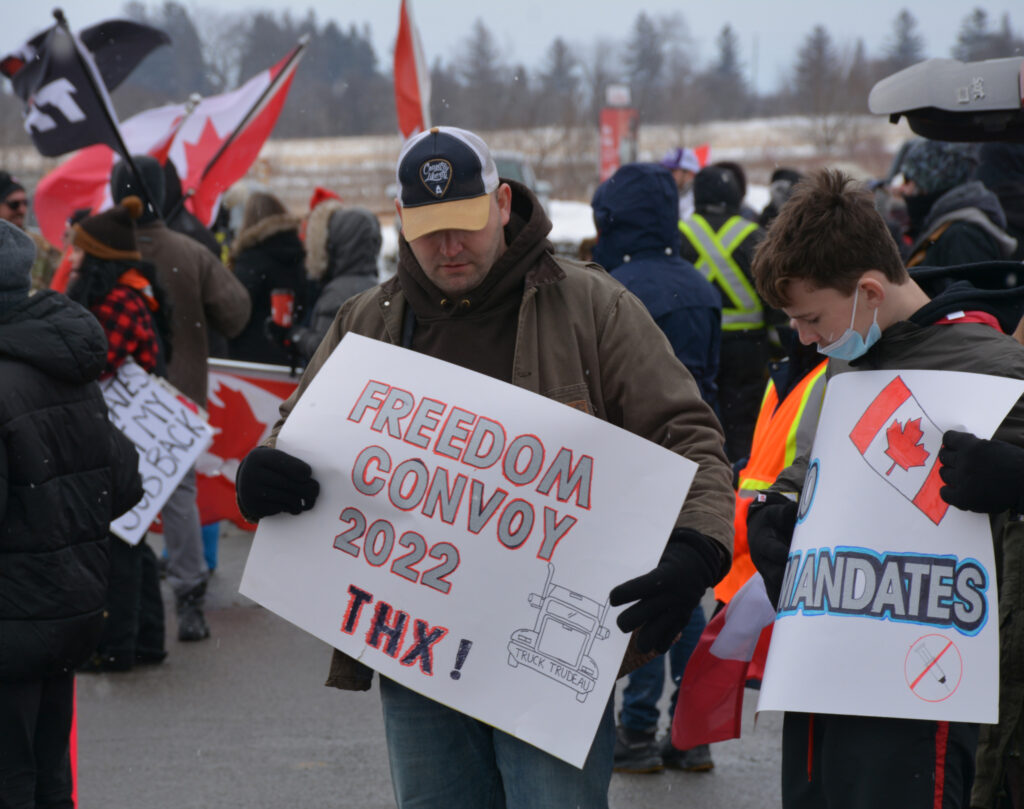Federal use of Emergencies Act against Freedom Convoy unreasonable, judge rules
A judge has ruled it was unreasonable for the Liberal government to use the Emergencies Act to quell “Freedom Convoy” protests in the national capital and at key border points two years ago.
In a decision released Jan. 23, Federal Court Justice Richard Mosley said invocation of the Act led to the infringement of constitutional rights.
The Canadian Civil Liberties Association and several other groups and individuals had argued in court that Ottawa ushered in the emergency measures without sound statutory grounds.

The government contended the steps taken to deal with the pan-Canadian turmoil were targeted, proportional, time-limited and compliant with the Charter of Rights and Freedoms.
The Public Order Emergency Commission, which carries out a mandatory review after invocation of the Emergencies Act, found the government met the very high legal standard for using the law.
Mosley heard arguments in court over three days last April.
In his ruling, Mosley said he revisited the events with the benefit of hindsight and a more extensive record of the facts and the law than the government had when it proclaimed a public order emergency.
“I have concluded that the decision to issue the Proclamation does not bear the hallmarks of reasonableness — justification, transparency and intelligibility — and was not justified in relation to the relevant factual and legal constraints that were required to be taken into consideration,” Mosley wrote.
Government to appeal ruling
Deputy Prime Minister Chrystia Freeland said the government respectfully disagrees with the decision and will appeal.
In early February 2022, downtown Ottawa was filled with protesters, many in large trucks that rolled into the city beginning in late January.
Ostensibly a demonstration against Covid-19 health restrictions, the gathering attracted people with a variety of grievances against Prime Minister Justin Trudeau and the Liberal government.
The usually calm streets around Parliament Hill were beset by blaring rig horns, diesel fumes, makeshift encampments and even a hot tub and bouncy castle as participants settled in.
Public anger against protesters
The influx of people, including some with roots in the far-right movement, prompted many businesses to close temporarily, and aggravated residents with noise, pollution and harassing behavior.
Public anger mounted over a lack of enforcement action by Ottawa police.
Meanwhile, trucks clogged key border crossings, including key routes to the United States at Windsor, Ont., and Coutts, Alta.
Emergencies Act and War Measures Act
On Feb. 14, the government invoked the Emergencies Act, which allowed for temporary measures including regulation and prohibition of public assemblies, the designation of secure places, direction to banks to freeze assets and a ban on support for participants.
It was the first time the law had been used since it replaced the War Measures Act in 1988.
In a Feb. 15 letter to premiers, Trudeau said the federal government believed it had reached a point “where there is a national emergency arising from threats to Canada’s security.”
The civil liberties association maintained that legal threshold was not met.
The Federal Court hearing included others who filed actions contesting use of the emergency measures: the Canadian Constitution Foundation, Canadian Frontline Nurses and Kristen Nagle, and individuals Jeremiah Jost, Edward Cornell, Vincent Gircys and Harold Ristau.
This report by The Canadian Press was first published Jan. 23.
Have your say
This is a moderated forum. Comments will no longer be published unless they are accompanied by a first and last name and a verifiable email address. (Today's Trucking will not publish or share the email address.) Profane language and content deemed to be libelous, racist, or threatening in nature will not be published under any circumstances.
In reading this article, I find it very disturbing that the events that took place are misrepresented,
I have several friends that were present for the protest, and there was no horn blaring, no public disturbance, if anything that did happen there the people help the communities clean up after snowfalls, and they encouraged local businesses.
I also find it very interesting that there is no mention in the media whatsoever of the fact that the OPP corral all the leftover trucks at the end of it all, and took the drivers away from their trucks, and then proceeded to break a window in every truck, searching them for people that may have been “hiding” in the trucks.
If you were really fortunate, you had both windows broken. It’s time to start telling the story the way it is and not what the government wants you to report. I hope the government loses its appeal.
-
Me too, agree with you 100%
The protest was as much about treatment of truck drivers and veterans as it was about the vaccine orders. Many people at the Toronto and Ottawa protest were pushing for paid sick days
Also for temporary housing for disabled and homeless veterans and truck drivers
If the ont gov had of the protest ers on those issues and the Federal gov had come up with a plan
The protest would have been much shorter
I was at the queen park protest and freighwavez and other news outlets tried to cover the issues
I and. Many others are very happy with this decision in court
The protest and the emergency act in response has slowed down foreign high skilled people from coming along with their money the key issues for truck drivers except for paid sick days still need more work
Nothing changed and no one will ever be held accountable for violating the rights of those present or the Canadian Charter of Rights that applies to all Canadians.
Obviously judge lives in a vacuum, we ottawa residents almost unanimously cheered the clearing out of the mobs